
by California Casualty | Homeowners Insurance Info, Safety |
Disaster can strike at ANY time during ANY season. So, each year we are here to remind you to prepare for disaster situations in your home and communities.
BE PREPARED: Before an emergency or natural disaster strikes, here are 10 things you can do:
- Plan and save for the unexpected financially.
- Sign up for emergency alerts in your area.
- Map out and practice using several different evacuation routes.
- Have a safe location planned for shelter if your town is evacuated.
- Plan for your pets and know where they will stay if you are evacuated. Here are some pet-friendly hotels.
- Have a plan where you and family members will meet and how you will communicate if you become separated.
- Create an emergency kit, that meets your family’s particular needs.
- Complete a home inventory and document all of your belongings (clothing, mattresses, bedding, kitchen appliances, furniture, electronics, etc.).
- Back up important phone contacts and photos physically or on The Cloud.
- Check your insurance coverage with an advisor, to make sure you’re adequately covered or add protection (ex. Home, Renters, Auto, Flood, Earthquake, Floater, and Umbrella).
BE READY: If you need to evacuate:
- To find local shelters download the FEMA app, text SHELTER and your ZIP code to 43362 (ex. SHELTER 12345), or visit the American Red Cross’ website.
- Contact California Casualty as soon as possible and save all receipts for living expenses, such as hotels, meals and other essentials.
- Monitor local media about conditions, further evacuations, or when it might be safe to return home.
BE SAFE: When you return home, there are many potential dangers, such as:
- Dangerous toxins, and debris
- Mold
- Gas leaks
- Electrical shock
- Poisonous snakes or other animals
- Structural instability and collapse
- Sewage and chemical tainted water
GET HELP: If you need recovery help afterward:
Though it is National Preparedness Month, it is important to remain prepared every month of the year. An emergency or natural disaster can strike at any time or place; and if it does, please remember, you are not alone. California Casualty is there when you need us most, to help make sure you and your family are covered.
This article is furnished by California Casualty, providing auto and home insurance to educators, law enforcement officers, firefighters and nurses. Get a quote at 1.866.704.8614 or www.calcas.com.
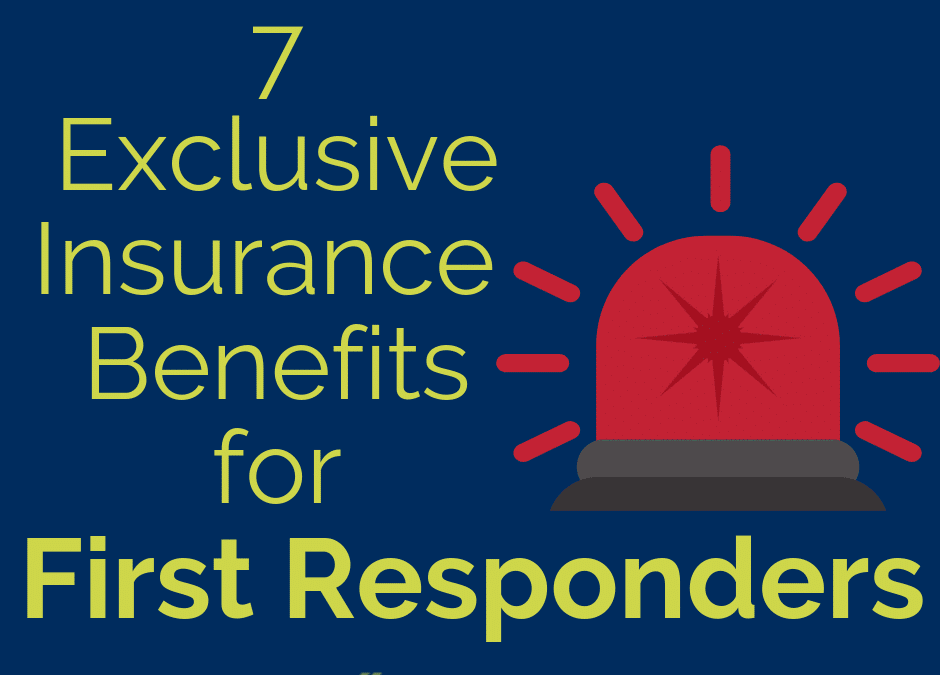
by California Casualty | Auto Insurance Info, Homeowners Insurance Info |
Being a first responder takes a lot of dedication, time, and training. You shouldn’t have to worry whether you have the right auto and home insurance. That’s why law enforcement and fire organizations have worked with California Casualty for decades to provide auto and home insurance to their members with exclusive benefits that are not available to the general public.
Here are 7 exclusive benefits for first responders from California Casualty:
- Waived Deductibles- California Casualty reduces the deductible up to $500 if your vehicle is vandalized or hit when parked where you work as a first responder.
- Personal Items in Your Vehicle- California Casualty includes $500 coverage for personal property (including turnout gear, safety equipment, and personal off-duty firearms) stolen from or damaged in your vehicle.
- Fallen Hero Benefit- California Casualty waives the insurance premium for the current year and the following year for the surviving spouse or partner of an insured firefighter or law enforcement officer who dies in the line of duty (not available in GA, MT, NH, TN and TX).
- Identity Protection- Each policy with California Casualty comes with FREE ID Theft protection and resolution services from CyberScout.
- Flexible Payment Options- Whether you like to pay one bill or do monthly installments, California Casualty lets you choose what works best for you. They also offer summer or holiday skip payment options so you can maximize your budget for the times when you need the money for other things.
- Insurance for Your Pets- Every auto insurance policy automatically includes up to $1,000 for vet bills if your pet is injured in a covered loss in your vehicle. California Casualty’s partner, Pets Best, also offers reduced rates for pet health insurance.
- Custom Parts and Accessories- California Casualty covers up to $2,000 for things you’ve added to your truck or van like custom rims, roll bars and furnishings (including pickup bed liners and covers).
Firefighter and Peace Officer associations have partnered with California Casualty because they have auto and home insurance policies tailored to best fit the lives of first responders. Be sure that you have all the coverage you need with the exclusive discounts you deserve. Contact a California Casualty adviser for a no-hassle policy review today, 1.866.704.8614 or https://www.calcas.com.
*All coverages may not be available in all states. In the case of any loss, the policy terms and conditions will apply.
This article is furnished by California Casualty, providing auto and home insurance to educators, law enforcement officers, firefighters and nurses. Get a quote at 1.866.704.8614 or www.calcas.com.
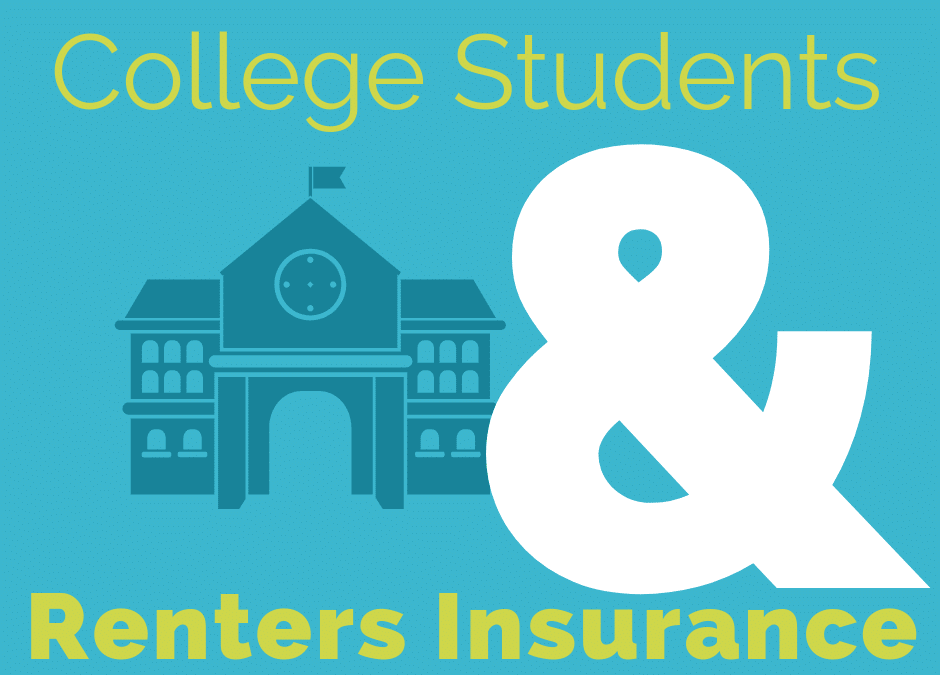
by California Casualty | Homeowners Insurance Info |
The rush is on to get everything ready as students head back to college. If yours are moving into a place of their own, don’t forget to purchase renters insurance to protect all the special items that make their new place their home away from home.
Here are some important reasons why it is a necessity for your college student(s) to have renters insurance:

1. College kids have more these days: books, bicycles, TVs, computers, tablets, gaming systems, smartphones, sound systems, clothes, bedding, furniture, and kitchen items. Replacing those items if they were stolen, damaged or destroyed in a fire could add up to tens of thousands of dollars. Renters insurance also pays for temporary living expenses, like a hotel room, while their room or apartment is being repaired.

2. Once they move into a place of their own they usually need their own renters insurance policy. Most students who live in a dorm have personal property coverage under their parents’ homeowners insurance.
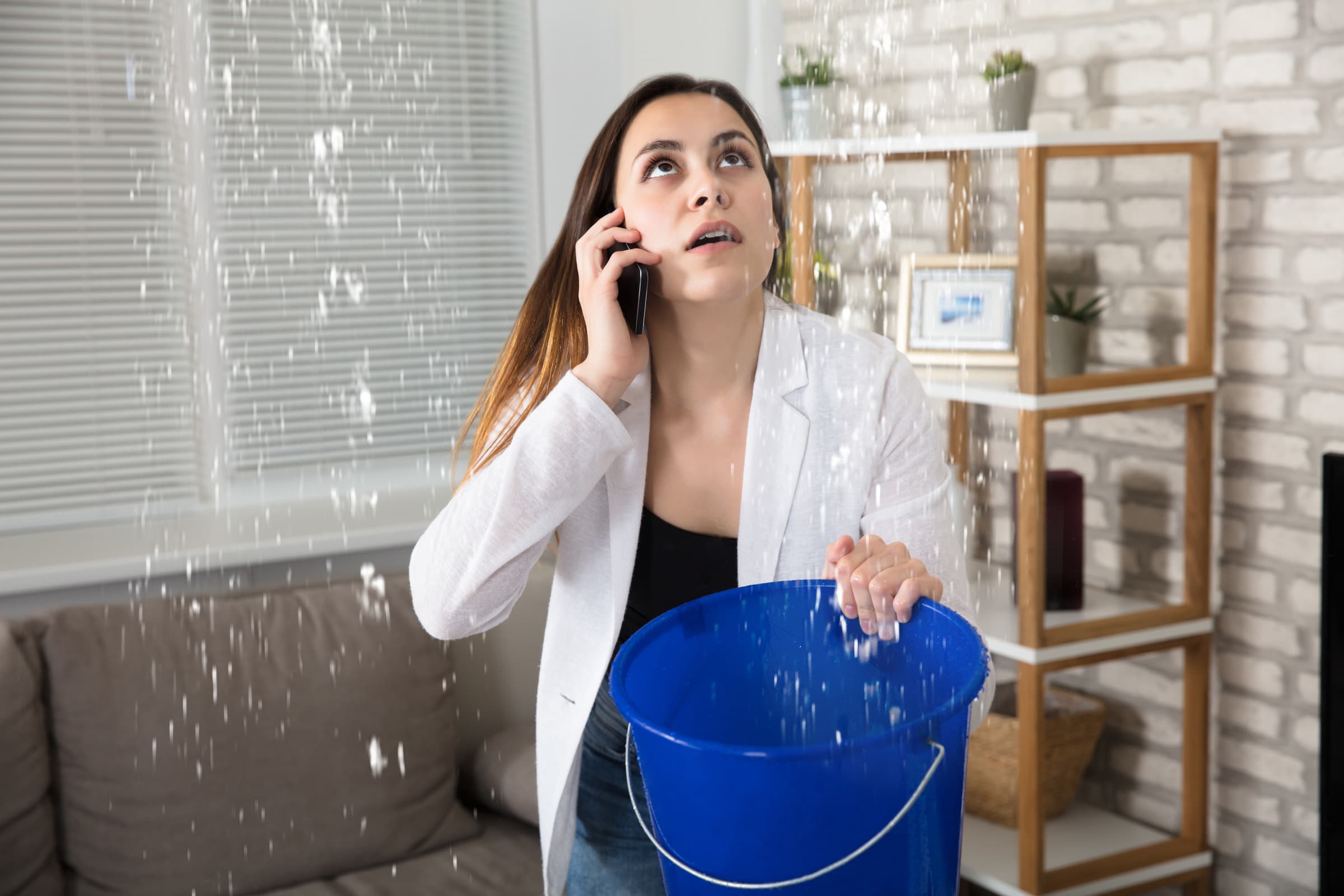
3. A landlord’s insurance policy won’t cover your student’s belongings. The landlord’s insurance protects the building and only pays to fix walls, roofs, etc., not any of your kid’s contents.

4. Renters insurance provides liability coverage if someone gets hurt at your student’s home/apartment. It helps pay for medical expenses and other costs, like legal fees, if the injured person sues.

5. Renters insurance a great value. On average, it costs between $10 and $20 a month, or about $200 a year. That’s less than most people spend each month for cell phones or their cable bill.
Policies from California Casualty also provide free ID theft protection from CyberScout, adding another layer of security in our modern world of social media, data breaches, and online trolls. Now is the time to find out how little renters insurance costs, and how it can cover your student’s belongings. Learn more by contacting an advisor today at 1.866.704.8614 or visit https://mycalcas.com/quote
This article is furnished by California Casualty. We specialize in providing auto and home insurance to educators, law enforcement officers, firefighters, and nurses.
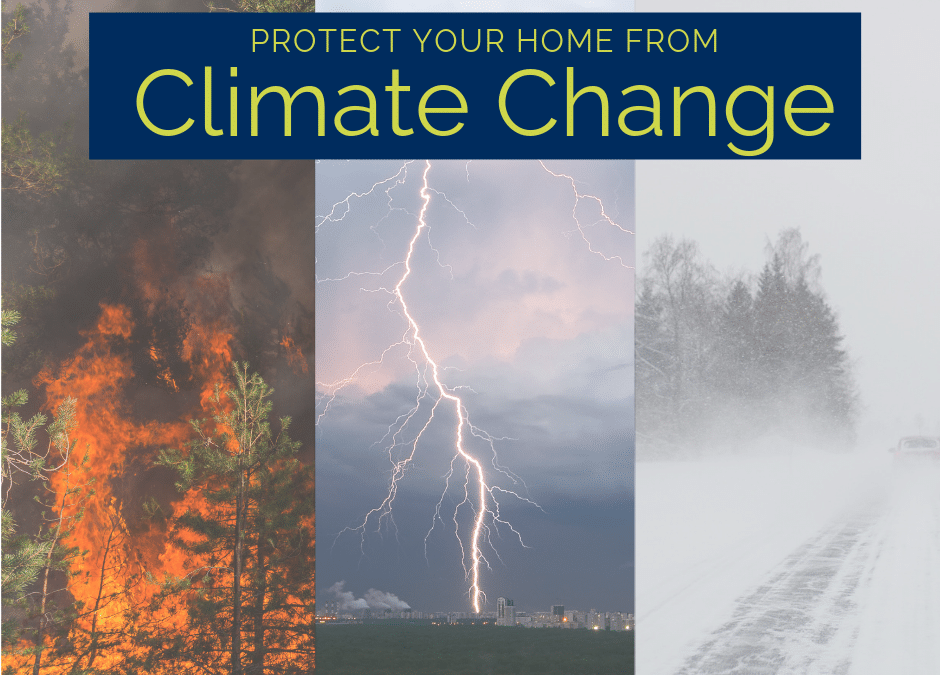
by California Casualty | Auto Insurance Info, Homeowners Insurance Info |
While there may be some debate about the cause, more and more people are accepting the fact that a changing climate is leading to extremely erratic weather with more intense storms, prolonged drought, and rising temperatures.
This has led to some of the most dramatic disasters in the U.S. Throughout these impressive weather swings, roofs have been damaged, homes flooded, trees toppled and vast acreage blackened. Many property owners are wondering what’s next and what they can do to safeguard their property?
Here are some important steps that you can take to help protect your property and your family from the major effects of climate change.
Storms
Snow and ice storms, hurricanes and spring/summer thunderstorms have become more intense. From record hail, tornado outbreaks, and torrential downpours; our homes and property are taking a beating.
When these storms hit, check and repair:
- Roofs and shingles
- Gutters and downspouts
- Decks and porches for loose, cracked or exposed wood
- Exterior for chipped or peeling paint, cracks, holes or exposed wood or siding
- Attics for evidence of leaks
- Basements or crawl spaces for damp areas and cracks
- Concrete slabs for cracks or shifting soil
- Chimneys for damage or dirty flues
- Trees and bushes for broken or weak trunks and branches, and removing any branches that overhang your home
Fire
Wildfires in much of the country have burned hotter and consumed more structures and acreage in recent years. Climate change has extended the fire season by an extra two months across the U.S.! In much of the South and West it begins in early spring, ending late fall.
Fire prevention experts recommend that anyone in or near a fire-prone area, especially what is called the Wildland Urban Interface (WUI), needs to take these steps to minimize their fire risk and help responding crews:
- Create at least a 100 foot defensible space area around homes and structures (200 feet or more may be needed on hillside areas)
- Keep combustible wood piles, propane tanks and other flammable materials 30 feet from homes and structures
- Remove weeds and dry shrubs near structures
- Keep laws trimmed and mowed
- Trim tree branches 10 feet up from the ground and remove any that overhang your home or other structures, and keep trees spaced 30 feet apart
- Install a fire resistant roof and deck
- Make sure your street name and address are visibly posted for emergency vehicles
- Clear flammable vegetation 10 feet from roads and five feet from driveways, and cut back overhanging branches on roads and drive ways
Keeping your home well maintained is essential to withstand the vagaries of weather. You can find more wildfire preparation tips here.
Know Your Insurance
In the event of these extreme storms it is also critical that you understand your insurance and know:
- If your homeowners policy includes replacement cost or actual cash value,
- Whether you are covered for new additions, improvements or appliance and other upgrades,
- That a floater or scheduled personal property endorsement is needed to fully cover high value items such as fine art, furs, jewelry, silverware and musical instruments
Keep in mind: flood and earthquake insurance are not included with your home or renters policy. However when you have California Casualty, you can easily add each to your policy though our agency services program. Please contact: 1.877.652.2638 or [email protected] .
Another important coverage you should add to your policy is comprehensive coverage. Without it your vehicle won’t be protected if it is damaged or destroyed by a flood, fire or falling tree limb. To ask a customer service representative about adding comprehensive coverage please contact: 1.800.800.9410 or visit www.calcas.com
Lastly, make sure your belongings are also completely covered in the event of a storm or fire. If you haven’t completed a home inventory yet, now is the time to do it. Having a list and proof of the things you own will help you with reimbursement if your home or apartment is damaged by a natural disaster. For our free Home Inventory Guide click here.
This article is furnished by California Casualty, providing auto and home insurance to educators, law enforcement officers, firefighters and nurses. Get a quote at 1.866.704.8614 or www.calcas.com.
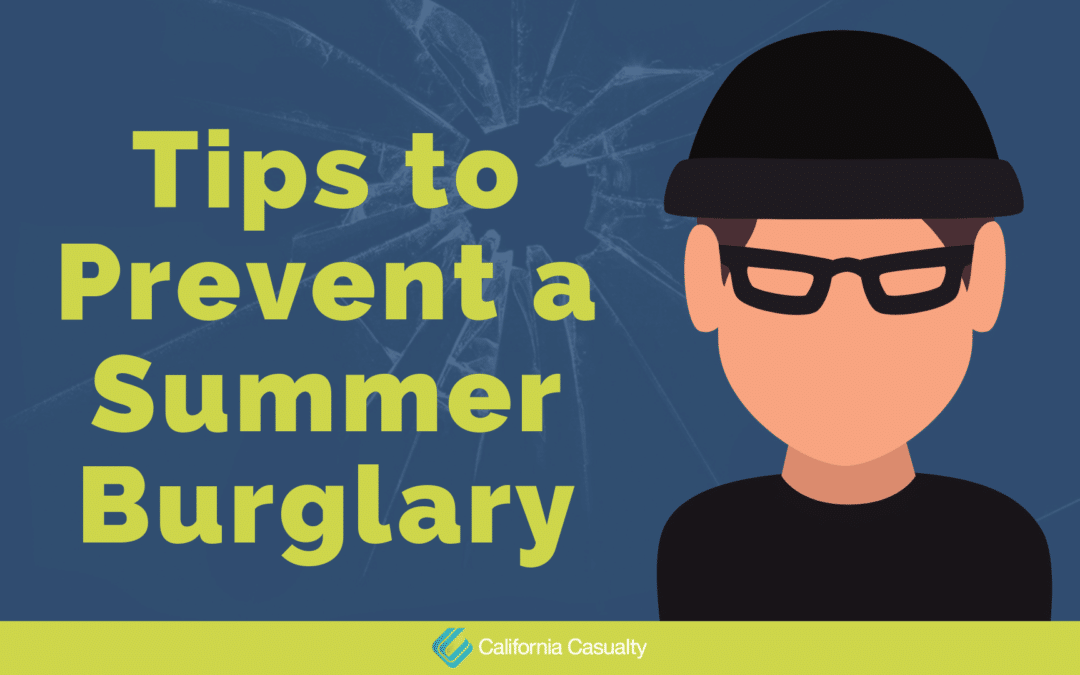
by California Casualty | Homeowners Insurance Info, Safety |
Summertime is in full swing! However, along with summer heat is the threat of summer burglary. Nobody wants to return home to find someone has burglarized their hard-earned possessions.
Unfortunately, the U.S. Department of Justice warns that break-ins heat up during the summer months. Most of those are crimes of opportunity from criminals looking for an easy target like open windows or garage doors.
Here are some tips to prevent a summer burglary:
Make Your Home Less Vulnerable
- Trim back bushes or hedges that block visibility and give a thief areas to hide
- Install outdoor lighting
- Put indoor lights on timers
- Have a security system installed
- Get a dog
- Keep garage doors closed
- Always lock doors and windows
- Keep watch of your neighbors’ homes and ask they do the same for you
- Have a trusted friend, neighbor or relative make trips to your home or park a car in the driveway to make it look lived in while you are away
Don’t Advertise to Criminals
- Stop mail and newspaper deliveries if you are going away
- Arrange for any home deliveries to your neighbors when you are not home
- Don’t leave garbage cans out while you are away
- Never leave notes on doors telling someone you are out and when you will return
- Leave a radio or TV on while you are away
- Conceal valuables and don’t them visible from the outside
- Break down and conceal boxes for expensive items and electronics when putting out the trash (boxes for the new 60” HD TV or the latest computer are like shopping flyers for thieves)
- Don’t advertise on social media that you are going away to grandma’s house or a wonderful vacation (this goes for your children)
Protect Yourself
- Make a complete home inventory of your possessions to assist if you need to file a police report, speed up an insurance claim and help with a tax-loss write off
- Be sure to have an identity theft protection and recovery service if burglars get access to your personal or banking information
- Protect your possessions with homeowners or renters insurance
Not only do you feel violated after someone breaks into your home, but it can be expensive to fix the damage and replace items. That’s why you need homeowners and renters insurance. We can’t stop all criminals, but California Casualty is here to protect you with quality auto and home insurance with exclusive benefits not available to the general public. Every policy also comes with free ID theft protection. Call an adviser today for a policy comparison or review at 1.800.800.9410, or visit www.calcas.com.
For more information visit:
https://bit.ly/2JXf93n
https://bit.ly/2YlWhDe
This article is furnished by California Casualty, providing auto and home insurance to teachers, law enforcement officers, firefighters and nurses. Get a quote at 1.866.704.8614 or www.calcas.com.
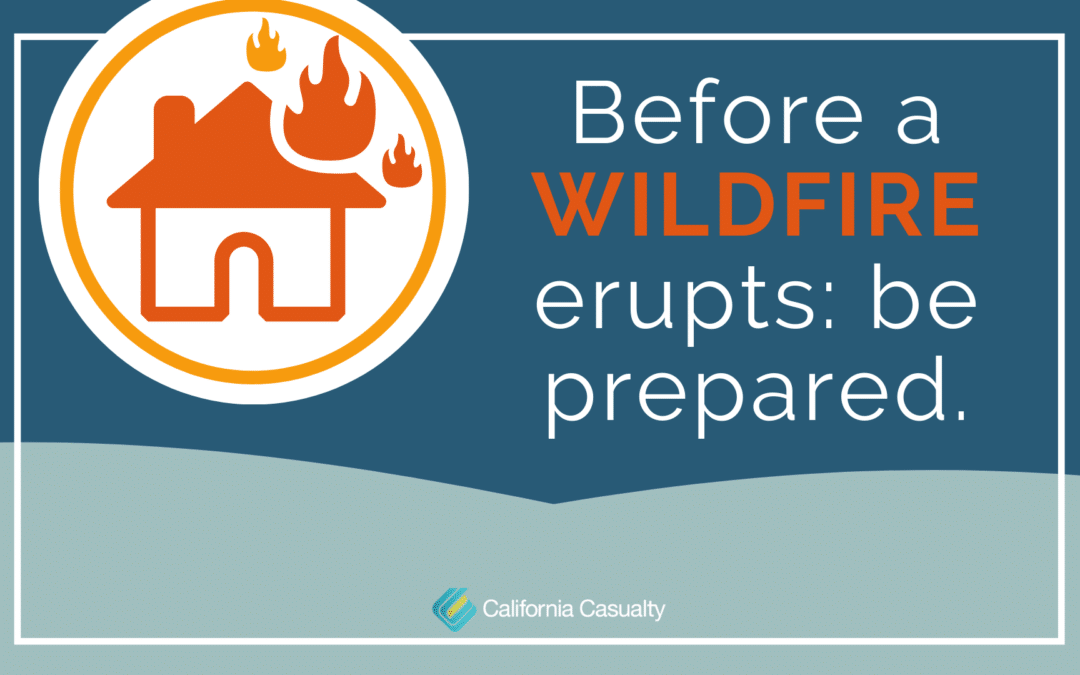
by California Casualty | Homeowners Insurance Info, Safety |
Wildfires seem to be burning faster and more intense than ever. The past few years have seen the largest and most destructive conflagrations in US history. Wildfire preparation tips are more important than ever.
Too many people have come back to find melted remnants of prized personal possessions; homes in ashes.
Here are five key wildfire preparation tips for your community or neighborhood:
- Create a home inventory. 60% of homeowners and renters have still not documented the things they own, which can cause post-fire/disaster headaches.
- Know where fire extinguishers are kept and teach everyone how to use them. Make them easily accessible in the event an of emergency.
- Have a family escape plan. Practice how you would exit your home from different rooms in the event of a fire and set a safe meeting point, away from the property, if you were to get separated.
- Prepare an emergency kit with important documents. Include copies of banking information, insurance policies, home mortgage and deeds, etc.
- Review and understand your insurance policy. Whether you are renting or owning, know what it pays and does not pay for. Get extra protection for collectibles and high-dollar possessions with a scheduled personal property endorsement.
While these are great wildfire preparation tips, there are several other things to keep in mind in you are effected :
- Contact your insurance company as soon as possible
- Secure the property from further damage
- Contact creditors, banks and appropriate agencies about credit cards, tax returns, Social Security cards or other papers that may have been scattered in the disaster
- Check your credit report to make sure nobody is using your personal information
- Be very wary of fly-by-night work crews and contractor fraud
Download and print your copy of these Wildfire Preparation Tips here.
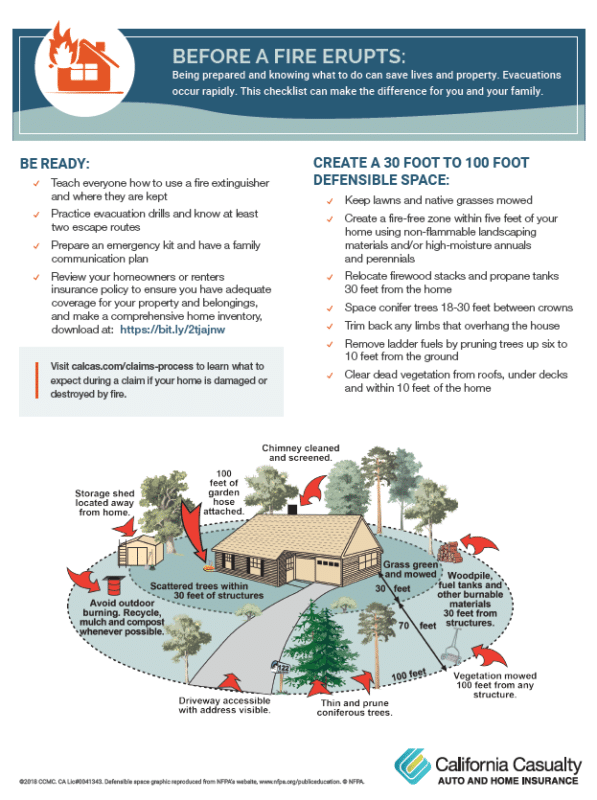
This article is furnished by California Casualty, providing auto and home insurance to educators, law enforcement officers, firefighters and nurses. Get a quote at 1.800.800.9410 or www.calcas.com.












